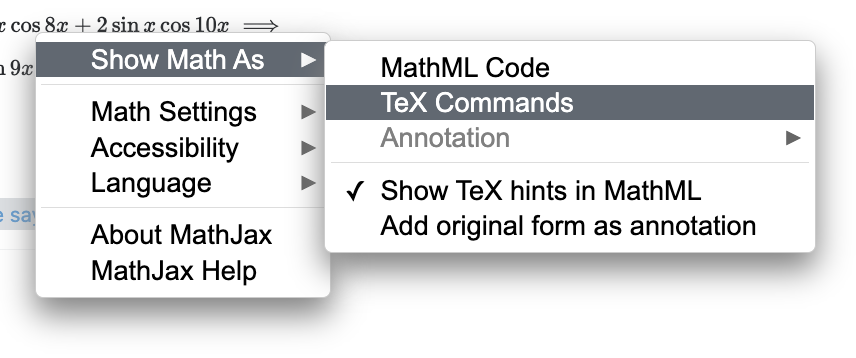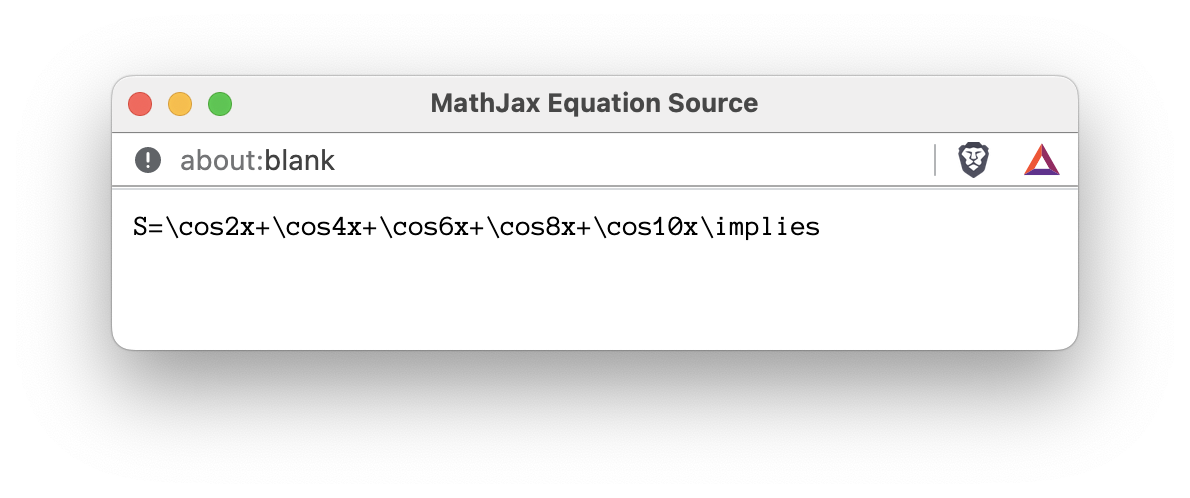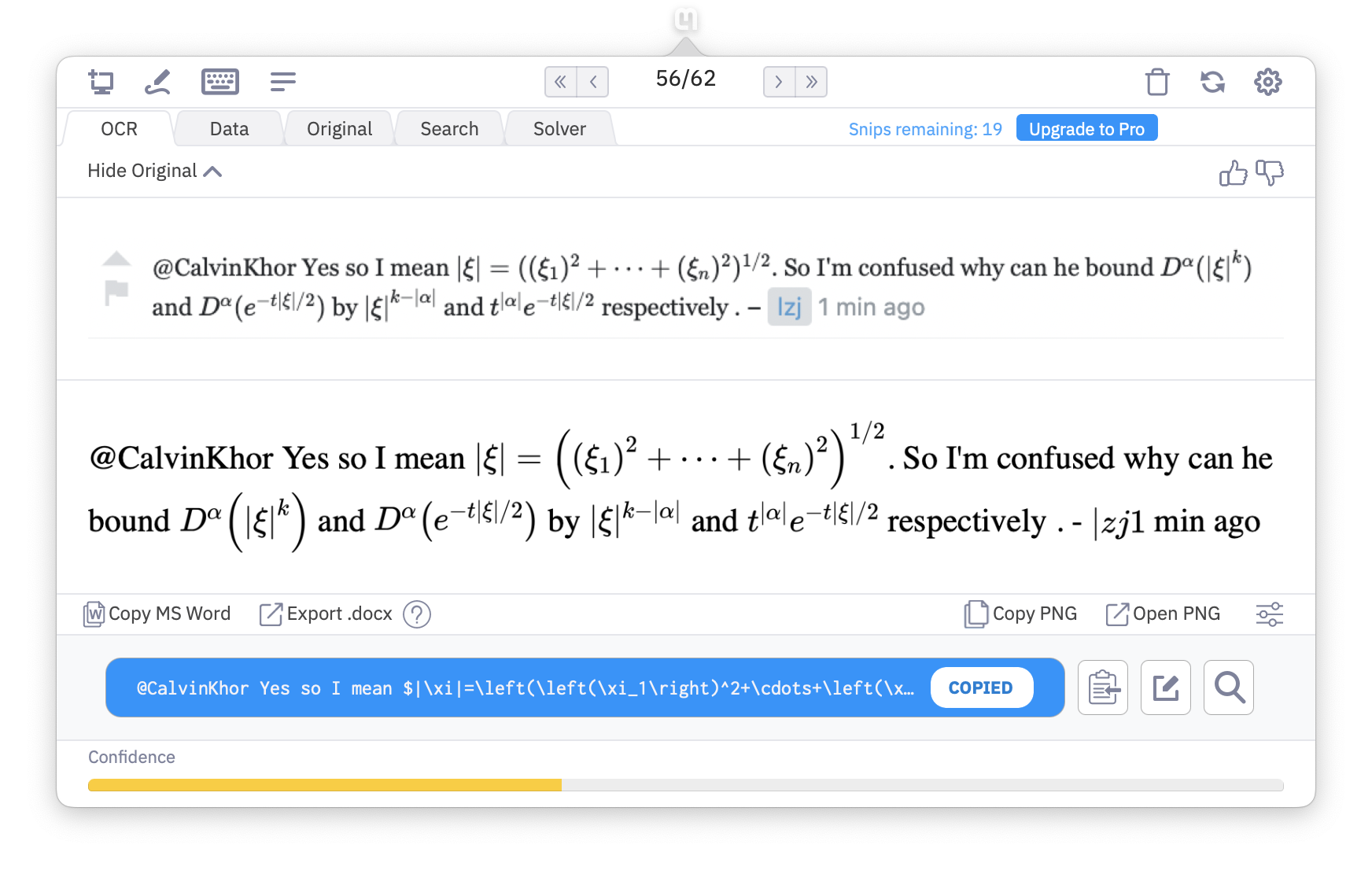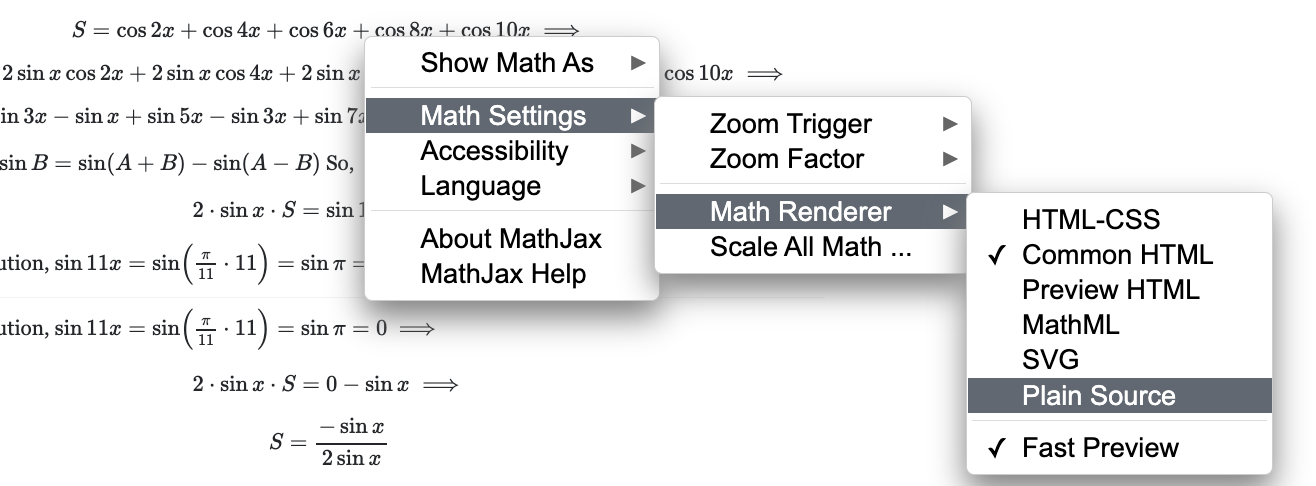I posted an answer to this question, and a commenter suggested an alternative. The commenter answer was simpler, more elegant than mine, and I would have upvoted it ... except he had posted it in the comments! When I asked the commenter to post his solution as an answer he declined, because he did not want to retype and copy/paste does not work well with Latex. Is there an alternative way to transfer a comment into to an answer?
-
2$\begingroup$ If you right-click on a formula, it will give a pop-up window that has "Show Math As" as an option. Clicking on that allows you to select "TeX commands", which will create a pop-up that you can copy and paste and will contain the material in MathJax. It means a couple of copy-n-paste, but no need to retype the formulas. Unfortunately, his MathJax is not very good, as it is several separate displayed equations rather than a single aligned display. $\endgroup$– Arturo MagidinCommented Oct 9, 2022 at 1:27
-
5$\begingroup$ @arturo maybe copy/paste this into the Answer section? $\endgroup$– Oscar LanziCommented Oct 9, 2022 at 1:42
-
$\begingroup$ Related question from before: math.meta.stackexchange.com/questions/26901/… $\endgroup$– Calvin KhorCommented Oct 9, 2022 at 5:35
-
2$\begingroup$ This came up on MathOverflow Meta relatively recently: Is it possible to see the source for a comment? In the answer I posted there, I included the link to: How to copy mixture of text and latex formulas in a comment? And also to a post on Meta Stack Exchange: Is there a way to view a comment's source? $\endgroup$– Martin SleziakCommented Oct 9, 2022 at 8:42
-
1$\begingroup$ If one of the concerns in this question is how to copy MathJax (LaTeX) from a comment, I'd guess the tag (mathjax) could be suitable here. $\endgroup$– Martin SleziakCommented Oct 9, 2022 at 8:46
2 Answers
Method A: Show Math As TeX Commands
For just a few blocks of Mathjax, you can do what Arturo suggests in the comments which is to right click* and choose to Show Math As TeX Commands:
 In the current scenario this is less than ideal because the different lines are put into their own Mathjax block:
In the current scenario this is less than ideal because the different lines are put into their own Mathjax block:
 so you will need to repeat, once for each line.
so you will need to repeat, once for each line.
Method B: Switch to Plain Source Math Renderer
To treat multiple blocks at once, you can switch the math renderer to Plain Source in the menu that appears on right click*
which gives you output which you can copy-paste:
For your and the commenter's reference I have copied the entire comment thread below. Note that some minor editing is still required (a few \begin{align}...\end{align}s will do).
I have an easier method of proving this...assume the sum to be S Then multiply both sides by 2\sin x where x=\pi/11 –
Everyone says FU
yesterday
Inquiring minds want to know ... can you show how this works in an answer? –
Oscar Lanzi
yesterday
Ofc, I'll write the answer tomorrow...i mean its midnight here –
Everyone says FU
yesterday
Let x=\frac{\pi}{11} and so let
S=\cos2x+\cos4x+\cos6x+\cos8x+\cos10x\implies
2\cdot\sin x\cdot S=2\sin x\cos2x+2\sin x\cos4x+2\sin x\cos6x+2\sin x\cos8x+2\sin x\cos10x\implies
2\cdot\sin x\cdot S=\sin3x-\sin x+\sin5x-\sin3x+\sin7x-\sin5x+\sin9x-\sin7x+\sin11x-\sin9x
I applied 2\cos A\sin B=\sin(A+B)-\sin(A-B) So,
2\cdot\sin x\cdot S=\sin11x-\sin x
Undo the substitution, \sin11x=\sin\left(\frac{\pi}{11}\cdot 11\right)=\sin\pi=0 –
Everyone says FU
13 hours ago
Undo the substitution, \sin11x=\sin\left(\frac{\pi}{11}\cdot 11\right)=\sin\pi=0 \implies
2\cdot\sin x\cdot S=0-\sin x \implies
S=\frac{-\sin x}{2\sin x}
or
S=\frac{-1}{2}
@Oscar Lanzi –
Everyone says FU
13 hours ago
@EveryonesaysFU not in the comments! Post in the answers! –
Oscar Lanzi
12 hours ago
I'll have to write this all over again...can someone with enough powers to edit my question, post this on my behalf?...But you can see it, can't you? –
Everyone says FU
11 hours ago
Can you copy/paste? –
Oscar Lanzi
11 hours ago
Ofc but it 'll not come in latex –
Everyone says FU
11 hours ago
Too late to edit your comment, which would have provided a workaround. I would paste and repair instead of retyping. –
Oscar Lanzi
10 hours ago
1
@EveryonesaysFU You can copy and paste the LaTeX commands by right clicking on a formula, selecting "Show Math As" and "TeX commands". It will give you a pop-up window with the Latex that you can then copy and paste. –
Arturo Magidin
3 hours ago
When you are done, you can change the Math Renderer back to see the compiled MathJax as usual.
Method C: rely on OCR to reproduce the comment(s)
See Is there an application where you can visually input LaTeX and have it translate to a code that works in Stack Exchange? and What tools can be used to extract MathJax/LaTeX from scanned input?
Here is an example result from MathPix on a different comment:

There are still other ways (pointed out by Martin). I will try to be brief; see Is it possible to see the source for a comment? on meta.MO for more info, and still other methods.
Method D: Link to the comments in a chatroom
Get the link to each comment you want and paste it in a SE Chatroom like The Sandbox.
 This comes with all the formatting like
This comes with all the formatting like $...$, but you will need to do this once for each comment. In addition, you need at least 20 reputation total across the SE network to chat.
Method E: Find the comment in SEDE
This is from Martin's answer to a different Math.meta question. Specifically, you can use this SEDE query. You need the comment to have been archived in SEDE, which is updated weekly. One upside of this method is that it also reveals the Markdown source.
At the time of writing the comments in question are now deleted, so for demonstration I put https://math.stackexchange.com/questions/733754/visually-stunning-math-concepts-which-are-easy-to-explain#comment1556601_734062 into the RawLink field. The result is the following table:
Copying from the Text field gives a slightly truncated comment, but ticking Text-only results and re-running, we get @MaximUmansky: That way you'd just get lines that get closer together and it'll be not as obvious. Here, you see the fractions $\frac{1}{2}$ and $\frac{1}{4}$ in their "standard shape", so what remains must _obviously_ be $\frac{1}{4}$. Then, put the same shapes inside the remaining square which is _of the same proportions as the initial one_ (and it's easily checked that $\frac{1}{2}\cdot\frac{1}{4}=\frac{1}{8}$); you'll get the next smaller square, hidden deeper in the corner. Repeat, and the square will shrink to a tiny dot (not a whole line, which may intuitively seem larger).
* At least, on a PC/Mac; see How do I change Math Renderer for MathJax? for other devices.
-
$\begingroup$ Hopefully this isn't a duplicate suggestion: I use StackPrinter. $\endgroup$– ryangCommented Jan 28, 2023 at 16:57
I, too, would refuse to post an answer there. The alternative tricks leading to a solution (plane rotations or use of complex roots of unity) have been used/posted/thoroughly dissected on our site on several occasions.
It is an "obvious" FAQ.
Noobs are welcome to try their hand at finding a good explanation. Six-digit-veterans should spot it as an obvious dupe pretty much on sight (or expect to be called out as rep-farmers). Don't know where the line is in-between?
-
3$\begingroup$ This is a tangential comment: your use of blockquotes to highlight parts of the text has the opposite effect for me, since text in a blockquote is de-emphasized compared to the surrounding text. I'm having to spend several minutes in confusion looking for where you are quoting these pieces of text from before realizing that you're just trying to highlight some text. It would be better to avoid using blockquotes for emphasis since they no longer have that yellow background. $\endgroup$ Commented Oct 9, 2022 at 7:16



